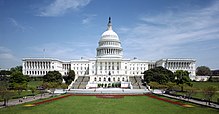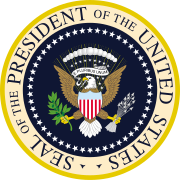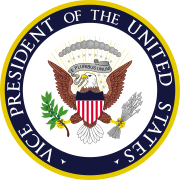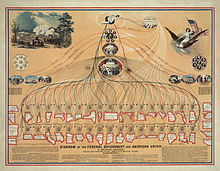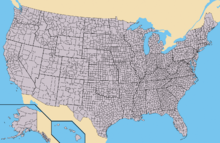
| |
| Formation | 1789 |
|---|---|
| Founding document | United States Constitution |
| Jurisdiction | United States of America |
| Website | www |
| Legislative branch | |
| Legislature | Congress |
| Meeting place | Capitol |
| Executive branch | |
| Leader | President |
| Appointer | Electoral College |
| Headquarters | The White House |
| Main organ | Cabinet |
| Departments | 15 |
| Judicial branch | |
| Court | Supreme Court |
| Seat | Washington, D.C. |
The federal government of the United States (U.S. federal government) is the national government of the United States, a federal republic in North America, composed of 50 states, a federal district, five major self-governing territories, and several island possessions. The federal government is composed of three distinct branches: legislative, executive, and judicial, whose powers are vested by the U.S. Constitution in the Congress, the president, and the federal courts, respectively. The powers and duties of these branches are further defined by acts of Congress, including the creation of executive departments and courts inferior to the Supreme Court.
Naming
Political system of the United States
The full name of the republic is "United States of America". No other
name appears in the Constitution, and this is the name that appears on
money, in treaties, and in legal cases to which it is a party (e.g. Charles T. Schenck v. United States).
The terms "Government of the United States of America" or "United
States Government" are often used in official documents to represent the
federal government as distinct from the states collectively. In casual
conversation or writing, the term "Federal Government" is often used,
and the term "National Government" is sometimes used. The terms
"Federal" and "National" in government agency or program names generally
indicate affiliation with the federal government (Federal Bureau of Investigation, National Oceanic and Atmospheric Administration, National Park Service). Because the seat of government is in Washington, D.C., "Washington" is commonly used as a metonym for the federal government.
History
The United States government is based on the principles of federalism and republicanism, in which power is shared between the federal government and state governments.
The interpretation and execution of these principles, including what
powers the federal government should have and how those powers can be
exercised, have been debated ever since the adoption of the
Constitution. Some make the case for expansive federal powers while
others argue for a more limited role for the central government in
relation to individuals, the states, or other recognized entities.
Since the American Civil War,
the powers of the federal government have generally expanded greatly,
although there have been periods since that time of legislative branch
dominance (e.g., the decades immediately following the Civil War) or
when states' rights
proponents have succeeded in limiting federal power through legislative
action, executive prerogative or by constitutional interpretation by
the courts.
One of the theoretical pillars of the U.S. Constitution is the idea of "checks and balances"
among the powers and responsibilities of the three branches of American
government: the executive, the legislative, and the judiciary. For
example, while the legislative branch (Congress) has the power to create law, the executive branch under the president can veto any legislation—an act which, in turn, can be overridden by Congress. The president nominates judges to the nation's highest judiciary authority, the Supreme Court, but those nominees must be approved by Congress. The Supreme Court, in turn, can invalidate unconstitutional laws passed by the Congress. These and other examples are examined in more detail in the text below.
Legislative branch
Seal of the U.S. Congress
The United States Congress, under Article I of the Constitution, is the legislative branch of the federal government. It is bicameral, comprising the House of Representatives and the Senate.
Makeup of Congress
House of Representatives
The 435 seats of the House grouped by state
The House currently consists of 435 voting members, each of whom represents a congressional district. The number of representatives each state has in the House is based on each state's population as determined in the most recent United States Census.
All 435 representatives serve a two-year term. Each state receives a
minimum of one representative in the House. In order to be elected as a
representative, an individual must be at least 25 years of age, must
have been a U.S. citizen
for at least seven years, and must live in the state that he or she
represents. There is no limit on the number of terms a representative
may serve. In addition to the 435 voting members, there are 6 non-voting
members, consisting of 5 delegates and one resident commissioner. There is one delegate each from the District of Columbia, Guam, the Virgin Islands, American Samoa, and the Commonwealth of the Northern Mariana Islands, and the resident commissioner from Puerto Rico.
Senate
In contrast, the Senate is made up of two senators from each state,
regardless of population. There are currently 100 senators (2 from each
of the 50 states), who each serve six-year terms. Approximately
one-third of the Senate stands for election every two years.
Different powers
The House and Senate each have particular exclusive powers. For example, the Senate must approve (give "advice and consent" to) many important presidential appointments, including cabinet officers, federal judges
(including nominees to the Supreme Court), department secretaries
(heads of federal executive branch departments), U.S. military and naval
officers, and ambassadors to foreign countries. All legislative bills
for raising revenue must originate in the House of Representatives. The
approval of both chambers is required to pass all legislation, which
then may only become law by being signed by the president (or, if the
president vetoes the bill, both houses of Congress then re-pass the bill, but by a two-thirds majority
of each chamber, in which case the bill becomes law without the
president's signature). The powers of Congress are limited to those
enumerated in the Constitution; all other powers are reserved to the
states and the people. The Constitution also includes the "Necessary and Proper Clause",
which grants Congress the power to "make all laws which shall be
necessary and proper for carrying into execution the foregoing powers".
Members of the House and Senate are elected by first-past-the-post voting in every state except Louisiana and Georgia, which have runoffs.
Impeachment of federal officers
Congress has the power to remove the president, federal judges, and
other federal officers from office. The House of Representatives and
Senate have separate roles in this process. The House must first vote to
"impeach" the official. Then, a trial is held in the Senate to decide
whether the official should be removed from office. Although two
presidents have been impeached by the House of Representatives (Andrew Johnson and Bill Clinton), neither of them was removed following trial in the Senate.
Congressional procedures
Article I, Section 2, paragraph 2 of the U.S. Constitution gives each
chamber the power to "determine the rules of its proceedings". From
this provision were created congressional committees, which do the work of drafting legislation and conducting congressional investigations into national matters. The 108th Congress
(2003–2005) had 19 standing committees in the House and 17 in the
Senate, plus 4 joint permanent committees with members from both houses
overseeing the Library of Congress,
printing, taxation, and the economy. In addition, each house may name
special, or select, committees to study specific problems. Today, much
of the congressional workload is borne by the subcommittees, of which
there are around 150.
Powers of Congress
The United States Capitol is the seat of government for Congress.
The Constitution grants numerous powers to Congress. Enumerated in
Article I, Section 8, these include the powers to levy and collect taxes;
to coin money and regulate its value; provide for punishment for
counterfeiting; establish post offices and roads, issue patents, create
federal courts inferior to the Supreme Court, combat piracies and felonies, declare war, raise and support armies, provide and maintain a navy, make rules for the regulation of land and naval forces, provide for, arm and discipline the militia, exercise exclusive legislation in the District of Columbia,
and to make laws necessary to properly execute powers. Over the two
centuries since the United States was formed, many disputes have arisen
over the limits on the powers of the federal government. These disputes
have often been the subject of lawsuits that have ultimately been
decided by the United States Supreme Court.
Congressional oversight
Congressional oversight is intended to prevent waste and fraud, protect civil liberties
and individual rights, ensure executive compliance with the law, gather
information for making laws and educating the public, and evaluate
executive performance.
It applies to cabinet departments, executive agencies, regulatory commissions, and the presidency.
Congress's oversight function takes many forms:
- Committee inquiries and hearings
- Formal consultations with and reports from the president
- Senate advice and consent for presidential nominations and for treaties
- House impeachment proceedings and subsequent Senate trials
- House and Senate proceedings under the 25th Amendment in the event that the president becomes disabled or the office of the vice president falls vacant
- Informal meetings between legislators and executive officials
- Congressional membership: each state is allocated a number of seats based on its representation (or ostensible representation, in the case of D.C.) in the House of Representatives. Each state is allocated two senators regardless of its population. As of January 2010, the District of Columbia elects a non-voting representative to the House of Representatives along with American Samoa, the U.S. Virgin Islands, Guam, Puerto Rico, and the Northern Mariana Islands.
Executive branch
The executive power in the federal government is vested in the president of the United States, although power is often delegated to the Cabinet members and other officials. The president and vice president are elected as running mates by the Electoral College, for which each state, as well as the District of Columbia, is allocated a number of seats based on its representation (or ostensible representation, in the case of D.C.) in both houses of Congress. The president is limited to a maximum of two four-year terms.
If the president has already served two years or more of a term to
which some other person was elected, he or she may only serve one more
additional four-year term.
President
Seal of the president of the United States
The executive branch, under Article II of the Constitution, consists
of the president and those to whom the president's powers are delegated.
The president is both the head of state and government, as well as the military commander-in-chief and chief diplomat.
The president, according to the Constitution, must "take care that the
laws be faithfully executed", and "preserve, protect and defend the
Constitution". The president presides over the executive branch of the
federal government, an organization numbering about 5 million people,
including 1 million active-duty military personnel and 600,000 postal service employees.
The president may sign legislation passed by Congress into law or may veto
it, preventing it from becoming law unless two-thirds of both houses of
Congress vote to override the veto. The president may unilaterally sign
treaties with foreign nations. However, ratification of international treaties requires a two-thirds majority vote in the Senate. The president may be impeached by a majority in the House and removed from office by a two-thirds majority in the Senate for "treason, bribery, or other high crimes and misdemeanors". The president may not dissolve Congress or call special elections but does have the power to pardon or release criminals convicted of offenses against the federal government (except in cases of impeachment), enact executive orders, and (with the consent of the Senate) appoint Supreme Court justices and federal judges.
Vice president
Seal of the vice president of the United States
The vice president is the second-highest official in rank of the
federal government. The vice president's duties and powers are
established in the legislative branch of the federal government under
Article 1, Section 3, Clauses 4 and 5 as the president of the Senate;
this means that he or she is the designated presiding officer of the
Senate. In that capacity, the vice president has the authority (ex officio, for they are not an elected member of the Senate) to cast a tie-breaking vote. Pursuant to the Twelfth Amendment, the vice president presides over the joint session of Congress when it convenes to count the vote of the Electoral College. As first in the U.S. presidential line of succession,
the vice president's duties and powers move to the executive branch
when becoming president upon the death, resignation, or removal of the
president, which has happened nine times in U.S. history. Lastly, in the case of a Twenty-fifth Amendment
succession event, the vice president would become acting president,
assuming all of the powers and duties of president, except being
designated as president. Accordingly, by circumstances, the Constitution
designates the vice president as routinely in the legislative branch,
or succeeding to the executive branch as president, or possibly being in
both as acting president pursuant to the Twenty-fifth Amendment.
Because of circumstances, the overlapping nature of the duties and
powers attributed to the office, the title of the office and other
matters, such has generated a spirited scholarly dispute regarding
attaching an exclusive branch designation to the office of vice
president.
Cabinet, executive departments, and agencies
The daily enforcement and administration of federal laws is in the hands of the various federal executive departments,
created by Congress to deal with specific areas of national and
international affairs. The heads of the 15 departments, chosen by the
president and approved with the "advice and consent" of the U.S. Senate,
form a council of advisers generally known as the president's
"Cabinet". Once confirmed, these "cabinet officers" serve at the
pleasure of the president. In addition to departments, a number of staff
organizations are grouped into the Executive Office of the President. These include the White House staff, the National Security Council, the Office of Management and Budget, the Council of Economic Advisers, the Council on Environmental Quality, the Office of the U.S. Trade Representative, the Office of National Drug Control Policy, and the Office of Science and Technology Policy. The employees in these United States government agencies are called federal civil servants.
There are also independent agencies such as the United States Postal Service (USPS), the National Aeronautics and Space Administration (NASA), the Central Intelligence Agency (CIA), the Environmental Protection Agency (EPA), and the United States Agency for International Development (USAID). In addition, there are government-owned corporations such as the Federal Deposit Insurance Corporation and the National Railroad Passenger Corporation.
Judicial branch
The Judiciary, under Article III of the Constitution, explains and
applies the laws. This branch does this by hearing and eventually making
decisions on various legal cases.
Overview of the federal judiciary
Seal of the U.S. Supreme Court
Article III section I of the Constitution establishes the Supreme Court of the United States
and authorizes the United States Congress to establish inferior courts
as their need shall arise. Section I also establishes a lifetime tenure
for all federal judges and states that their compensation may not be
diminished during their time in office. Article II section II
establishes that all federal judges are to be appointed by the president
and confirmed by the United States Senate.
The Judiciary Act of 1789 subdivided the nation jurisdictionally into judicial districts
and created federal courts for each district. The three tiered
structure of this act established the basic structure of the national
judiciary: the Supreme Court, 13 courts of appeals, 94 district courts,
and two courts of special jurisdiction. Congress retains the power to
re-organize or even abolish federal courts lower than the Supreme Court.
The U.S. Supreme Court decides "cases and controversies"—matters
pertaining to the federal government, disputes between states, and
interpretation of the United States Constitution, and, in general, can
declare legislation or executive action made at any level of the
government as unconstitutional, nullifying the law and creating precedent for future law and decisions. The United States Constitution does not specifically mention the power of judicial review (the power to declare a law unconstitutional). The power of judicial review was asserted by Chief Justice Marshall in the landmark Supreme Court Case Marbury v. Madison
(1803). There have been instances in the past where such declarations
have been ignored by the other two branches. Below the U.S. Supreme
Court are the United States Courts of Appeals, and below them in turn are the United States District Courts,
which are the general trial courts for federal law, and for certain
controversies between litigants who are not deemed citizens of the same
state ("diversity jurisdiction").
There are three levels of federal courts with general jurisdiction, meaning that these courts handle criminal cases and civil lawsuits between individuals. Other courts, such as the bankruptcy courts and the Tax Court, are specialized courts handling only certain kinds of cases ("subject matter jurisdiction"). The Bankruptcy Courts are "under" the supervision of the district courts, and, as such, are not considered part of the "Article III"
judiciary and also as such their judges do not have lifetime tenure,
nor are they Constitutionally exempt from diminution of their
remuneration. Also the Tax Court is not an Article III court (but is, instead an "Article I Court").
The district courts are the trial courts wherein cases that are
considered under the Judicial Code (Title 28, United States Code)
consistent with the jurisdictional precepts of "federal question jurisdiction" and "diversity jurisdiction" and "pendent jurisdiction" can be filed and decided. The district courts can also hear cases under "removal jurisdiction",
wherein a case brought in State court meets the requirements for
diversity jurisdiction, and one party litigant chooses to "remove" the
case from state court to federal court.
The United States Courts of Appeals are appellate courts that
hear appeals of cases decided by the district courts, and some direct
appeals from administrative agencies, and some interlocutory appeals.
The U.S. Supreme Court hears appeals from the decisions of the courts of
appeals or state supreme courts, and in addition has original jurisdiction over a few cases.
The judicial power extends to cases arising under the Constitution, an Act of Congress; a U.S. treaty; cases affecting ambassadors, ministers and consuls
of foreign countries in the U.S.; cases and controversies to which the
federal government is a party; controversies between states (or their
citizens) and foreign nations (or their citizens or subjects); and
bankruptcy cases (collectively "federal-question jurisdiction"). The Eleventh Amendment
removed from federal jurisdiction cases in which citizens of one state
were the plaintiffs and the government of another state was the
defendant. It did not disturb federal jurisdiction in cases in which a
state government is a plaintiff and a citizen of another state the
defendant.
The power of the federal courts extends both to civil actions for
damages and other redress, and to criminal cases arising under federal
law. The interplay of the Supremacy Clause and Article III has resulted
in a complex set of relationships between state and federal courts.
Federal courts can sometimes hear cases arising under state law pursuant
to diversity jurisdiction,
state courts can decide certain matters involving federal law, and a
handful of federal claims are primarily reserved by federal statute to
the state courts (for example, those arising from the Telephone Consumer Protection Act of 1991). Both court systems thus can be said to have exclusive jurisdiction in some areas and concurrent jurisdiction in others.
The U.S. Constitution safeguards judicial independence by
providing that federal judges shall hold office "during good behavior";
in practice, this usually means they serve until they die, retire, or
resign. A judge who commits an offense while in office may be impeached
in the same way as the president or other officials of the federal
government. U.S. judges are appointed by the president, subject to
confirmation by the Senate. Another Constitutional provision prohibits
Congress from reducing the pay of any Article III judge (Congress is
able to set a lower salary for all future judges that take office after
the reduction, but may not decrease the rate of pay for judges already
in office).
Relationships between state and federal courts
Separate from, but not entirely independent of, this federal court
system are the court systems of each state, each dealing with, in
addition to federal law when not deemed preempted, a state's own laws,
and having its own court rules and procedures. Although state
governments and the federal government are legally dual sovereigns,
the Supreme Court of the United States is in many cases the appellate
court from the State Supreme Courts (e.g., absent the Court
countenancing the applicability of the doctrine of adequate and independent State grounds). The Supreme Courts of each state
are by this doctrine the final authority on the interpretation of the
applicable state's laws and Constitution. Many state constitution
provisions are equal in breadth to those of the U.S. Constitution, but
are considered "parallel" (thus, where, for example, the right to
privacy pursuant to a state constitution is broader than the federal
right to privacy, and the asserted ground is explicitly held to be
"independent", the question can be finally decided in a State Supreme
Court—the U.S. Supreme Court will decline to take jurisdiction).
A State Supreme Court, other than of its own accord, is bound only by the U.S. Supreme Court's interpretation of federal law, but is not
bound by interpretation of federal law by the federal court of appeals
for the federal circuit in which the state is included, or even the
federal district courts located in the state, a result of the dual sovereigns concept. Conversely, a federal district court hearing a matter involving only a question of state law (usually through diversity jurisdiction) must apply the substantive law of the state in which the court sits, a result of the application of the Erie Doctrine; however, at the same time, the case is heard under the Federal Rules of Civil Procedure, the Federal Rules of Criminal Procedure and the Federal Rules of Evidence instead of state procedural rules (that is, the application of the Erie Doctrine only extends to a requirement that a federal court asserting diversity jurisdiction apply substantive state law, but not procedural state law, which may be different). Together, the laws of the federal and state governments form U.S. law.
Budget
The budget document often begins with the president's proposal to Congress recommending funding levels for the next fiscal year, beginning October 1 and ending on September 30 of the year following. The fiscal year refers to the year in which it ends.
For fiscal year (FY) 2018, the federal government spent $4.11 trillion. Spending equalled 20.3% of gross domestic product (GDP), equal to the 50-year average.
The deficit equalled $779 billion, 3.8 percent of GDP. Tax revenue
amounted to $3.33 trillion, with receipt categories including individual
income taxes ($1,684B or 51%), Social Security/Social Insurance taxes
($1,171B or 35%), and corporate taxes ($205B or 6%).
Elections and voting
Suffrage,
known as the ability to vote, has changed significantly over time. In
the early years of the United States, voting was considered a matter for
state governments, and was commonly restricted to white men who owned
land. Direct elections were mostly held only for the U.S. House of
Representatives and state legislatures, although what specific bodies
were elected by the electorate varied from state to state. Under this
original system, both senators
representing each state in the U.S. Senate were chosen by a majority
vote of the state legislature. Since the ratification of the Seventeenth Amendment in 1913, members of both houses of Congress have been directly elected. Today, U.S. citizens have almost universal suffrage under equal protection of the laws from the age of 18, regardless of race, gender, or wealth. The only significant exception to this is the disenfranchisement of convicted felons, and in some states former felons as well.
Under the U.S. Constitution, the representation of U.S. territories and the federal district of District of Columbia in Congress is limited:
while residents of the District of Columbia are subject to federal laws
and federal taxes, their only congressional representative is a non-voting delegate; however, they have been allowed to participate in presidential elections since March 29, 1961. Residents of U.S. territories have varying rights; for example, only some residents of Puerto Rico
pay federal income taxes (though all residents must pay all other
federal taxes, including import/export taxes, federal commodity taxes
and federal payroll taxes, including Social Security and Medicare).
All federal laws that are "not locally inapplicable" are automatically
the law of the land in Puerto Rico but their current representation in
the U.S. Congress is in the form of a Resident Commissioner, a nonvoting delegate.
State, tribal, and local governments
State governments have the greatest influence over most Americans' daily lives. The Tenth Amendment
prohibits the federal government from exercising any power not
delegated to it by the Constitution; as a result, states handle the
majority of issues most relevant to individuals within their
jurisdiction. Because state governments are not authorized to print
currency, they generally have to raise revenue through either taxes or
bonds. As a result, state governments tend to impose severe budget cuts
or raise taxes any time the economy is faltering.
Each state has its own written constitution, government and code
of laws. The Constitution stipulates only that each state must have, "a
Republican Government". Therefore, there are often great differences in
law and procedure between individual states, concerning issues such as
property, crime, health and education, amongst others. The highest
elected official of each state is the Governor, with below him being the Lieutenant Governor. Each state also has an elected state legislature (bicameralism is a feature of every state except Nebraska), whose members represent the voters of the state. Each state maintains its own state court
system. In some states, supreme and lower court justices are elected by
the people; in others, they are appointed, as they are in the federal
system.
As a result of the Supreme Court case Worcester v. Georgia, American Indian tribes are considered "domestic dependent nations" that operate as sovereign
governments subject to federal authority but, in some cases, outside of
the jurisdiction of state governments. Hundreds of laws, executive
orders and court cases have modified the governmental status of tribes vis-à-vis
individual states, but the two have continued to be recognized as
separate bodies. Tribal governments vary in robustness, from a simple
council used to manage all aspects of tribal affairs, to large and
complex bureaucracies with several branches of government. Tribes are
currently encouraged to form their own governments, with power resting
in elected tribal councils, elected tribal chairpersons, or religiously
appointed leaders (as is the case with pueblos).
Tribal citizenship and voting rights are typically restricted to
individuals of native descent, but tribes are free to set whatever
citizenship requirements they wish.
The institutions that are responsible for local government within
states are typically town, city, or county boards, water management
districts, fire management districts, library districts and other
similar governmental units which make laws that affect their particular
area. These laws concern issues such as traffic, the sale of alcohol and
the keeping of animals. The highest elected official of a town or city
is usually the mayor. In New England, towns operate in a direct democratic fashion, and in some states, such as Rhode Island, Connecticut, and some parts of Massachusetts,
counties have little or no power, existing only as geographic
distinctions. In other areas, county governments have more power, such
as to collect taxes and maintain law enforcement agencies.



